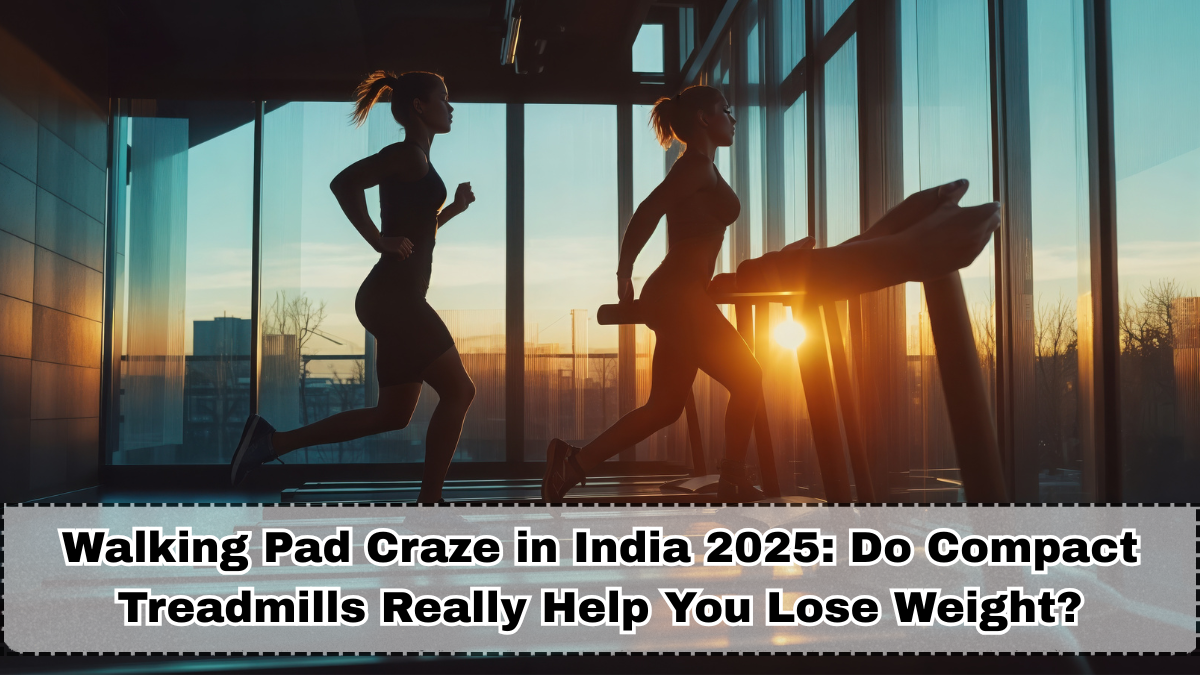In 2025, walking pads have become one of the hottest at-home fitness trends in India. These slim, foldable treadmills are everywhere—Instagram reels, office desk setups, and small apartments. People are using them for workday steps, weight loss, and even late-night stress relief. With tight schedules and limited space, the rise of walking pad workouts India feels almost inevitable.
The appeal is simple: you can walk anytime, anywhere, without needing a full gym setup. But do these compact machines actually help you lose weight and stay fit? Or are they just another trending gadget? The answer depends on how consistently you use them and whether you include them as part of your daily movement.

Why Walking Pads Are Becoming Popular in Indian Homes
Many Indian cities now see long working hours, long commutes and limited room for exercise. Walking pads offer a convenient solution by fitting under desks, beds or sofas. People can walk while answering calls, attending meetings or watching OTT shows.
The affordability factor also plays a role. With new brands offering budget-friendly models, more Indians are choosing walking pads over bulky treadmills. They require less electricity, less maintenance and almost no space.
Do Walking Pads Actually Help With Weight Loss?
Yes—walking pads help with weight loss when used regularly. The biggest advantage is increased daily movement. Many Indians struggle to hit 8,000–10,000 steps a day, which is where walking pads make the difference.
Weight loss happens through consistency. Short walks every few hours boost NEAT (Non-Exercise Activity Thermogenesis), which burns calories throughout the day. This passive calorie burn is one reason walking pad workouts India are becoming so popular in desk-job households.
How Walking Pads Boost Daily Steps Without Effort
Walking pads make movement automatic. You can walk while working, scrolling or relaxing, which removes the mental resistance of going outdoors or to a gym. Over time, these small sessions add up to major step counts.
People working from home especially benefit. Instead of long sitting hours, they can take 5–10 minute walking breaks every hour. This improves blood flow, posture and general energy levels throughout the day.
Best Ways to Use a Walking Pad at Home
Start slowly with 10–15 minutes twice a day. Gradually increase to 45–60 minutes as your stamina improves. You can also split your walking into smaller intervals that fit easily into a busy schedule.
Placing the walking pad under your work desk is the most effective setup. This allows you to walk at 2–4 km/h while typing or attending meetings. It’s gentle, quiet and sustainable without making you tired.
Walking Pad vs Outdoor Walking: Which Is Better?
Both are effective, but walking pads are more consistent for urban Indian lifestyles. Outdoor walking depends on weather, pollution and safety, which often becomes irregular. A walking pad makes daily walking more predictable.
However, outdoor walking offers sunlight exposure and fresh air, which are great for mood and vitamin D. The best combination is using both—walking pad for convenience and outdoor walks whenever possible.
Are Walking Pads Safe for Beginners?
Walking pads are beginner-friendly because they allow low-impact movement. The speed stays controlled and the flat platform reduces strain on the knees. This makes them ideal for people who are overweight, recovering from injury or easing into fitness.
Still, posture matters. Keep your shoulders relaxed and avoid leaning forward when walking under a desk. Using a stable desk height avoids wrist and back strain.
Benefits Beyond Weight Loss
Walking pads help improve mood by reducing stress hormones. Even a 10-minute walk can boost clarity and reduce mental fatigue. This is especially useful for people working high-pressure corporate jobs.
They also help with digestion when used after meals. A slow-paced walk supports metabolism and prevents bloating. Regular walking can also help control blood sugar, which is important for Indian families with diabetes risk.
Mistakes Indians Make When Using Walking Pads
Walking too fast while working can affect posture. It’s better to stick to a slow and steady pace. Some people also walk barefoot, which may cause arch strain. Light walking shoes offer better support.
Another mistake is ignoring the need for rest. Indoors walking is convenient, but the body still needs breaks to avoid overuse injuries. Alternating walking and sitting helps maintain balance.
Who Should Definitely Try a Walking Pad?
Desk workers, students preparing for exams, homemakers and senior citizens can all benefit. People living in small apartments, PGs or hostels also find walking pads extremely practical.
Those with joint pain or stiffness can use walking pads for gentle mobility. The controlled environment reduces impact and prevents sudden pressure on the knees.
FAQs
Can walking pads replace the gym?
They can improve daily movement but do not replace strength training or cardio workouts.
How many minutes should you walk on a walking pad daily?
Aim for 30–60 minutes total, broken into small intervals.
Are walking pads good for weight loss?
Yes, when used consistently with a healthy diet.
Can senior citizens use walking pads?
Yes, they are safe at slow speeds and provide low-impact movement.
Do walking pads consume a lot of electricity?
No, they use significantly less power than traditional treadmills.
Click here to know more.
